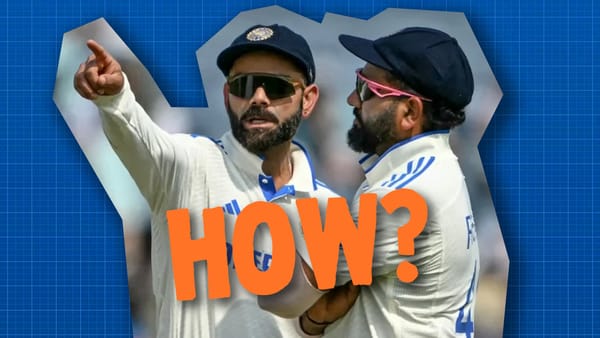Fawad Alam and his numbers
The man who waited a long time for a duck, and why that wait might have happened.
Fawad Alam has three numbers, 3910, 12265 and 3.
And together they make up an incredible story of a man who has been out of the Pakistan team for 3910 days, made 12265 first class runs and only managed three Tests. It's impossible to see those numbers and think Alam shouldn't have played more. Perhaps he was the fourth-best batsman in Pakistan for long periods during his banishment. And so once you say that, clearly he should have been picked. But that's not the only criteria, it's worth looking at why he wasn't.
Problem one: clog
The most obvious reason he hasn't played, he's a middle order player who overlaps with other middle order players. There are essentially two spots that Alam could have been used, batting five or six. Misbah Ul Haq took five for a lot of that time. That spot was not available to Alam. And these things happen in cricket. You can be the second-best wicketkeeper in the world while the best one is the same age from the same country and you're not playing many Tests.
And teams tend to create more players at certain positions due to their conditions. Australia finds a new tall bowler every few years; South Africa seem to grow seam bowling all rounders and Sri Lanka has more wicketkeepers than you need.
Look at England; Glen Chapple took 985 first class wickets between 1992 and 2013. But he really becomes incredible around 1998, and by 1999 he was clearly a Test bowler. At that point England had Andy Caddick and Darren Gough; dropping them wasn't an option. And in 2000 Matthew Hoggard came along. Now they could have gone with Chapple, but Hoggard took his chance and took 248 Test wickets. In 2003, Jimmy Anderson started his career. Chapple scored six first class hundreds with his heaps of wickets. He was good enough for Test level, but this is how things happen sometimes. Most of Pakistan's greatest batsmen have batted middle order.
But that explains number five, what about at six? Well, six is a weird batting position, it's not always your sixth best batsman. No batsman has ever made over 3200 runs at six, at five the record is 6883. Even seven has 3948 runs as its highest, and four have passed 3000, only two have passed it at six. Six is a multi-purpose batting position.
Of the top ten run-scorers in history at six, five are all rounders. When it's not them, it's often former greats who are being kept around and given a smoother ride to keep their experience in the team. The other function six is to develop batsmen, a safe spot to land. The 16th highest scoring number six is Ricky Ponting, Ian Bell is 26th. Pakistan have used this spot in that way, Babar Azam, Haris Sohail, Umar Akmal, all natural talents who were not ready to bat higher when they entered the team.

But they weren't there for long, but one man was. The second-highest scorer at number six, Asad Shafiq. The reason Shafiq stayed at six was that it was tricky to move him with Misbah and Younis Khan in the team. (There is a great piece on Shafiq/Alam by Osman). So he got to bat in the easiest position in Tests for a long time, which also possibly stifled his development. But for Alam, it meant that the two apparent places he could bat, he couldn't.
Problem two: position
This is linked to the previous point of why Fawad Alam can only bat at number five or six in Test cricket. If you take for granted - and teams seem to now - that number four is for the best non-opening batsman. And Alam is not an opener. Number three, five and six are the three spots, and five and six were taken.
In Alam's first class record, less than five percent of the time he's batted in the top three, so realistically that's not a chance for Tests. And you can see he's batted at four only 21%, which means that he's been top four barely over a quarter of the time.

And this might not seem like anything to you, but to cricketers and - most importantly - selectors, it matters. There is a shibboleth involved with where you bat in first class cricket. So many times I'll tell a pro cricketer about a batsman in first class cricket, and the next question I'm asked where they bat. If it's lower than four, they're not seen as (Test) batsmen.
At Test level, you are usually facing four high-quality bowlers. That means there's no let up. And being that bowling with the new ball is easier than not for most bowlers, there's usually a drop off in quality once the new ball is gone.
You may not remember a few years ago, but Glenn Maxwell was in trouble for speaking out about batting positions. The story was more about him speaking out on his captain, but it had it's root in him wanting to bat higher up the order to prove he was a Test player. And the captain of Victoria - Matthew Wade - was taking up the higher spot.
Now some of this is rubbish; Pakistan are the kings of reverse and has a lot of spinners around. So batting at five there might be harder than other places. But, Fawad Alam does not live in a cabin in the woods, he's aware of how cricketers talk. Since 2015, he's batted at four only once, because a top order player was injured. And almost all of his batting at four comes between 2013 and 2015, where he clearly went up the order for a reason. My guess - and this is a total shot in the dark - he realised he had to, as he'd only flirted with it in 19 innings previously. But perhaps it was a team thing.
Either way, for the last five years, he's batting at five in first class cricket. That's a license to print money if you're a talented player. The problem is, according to cricket lore, the currency is over-inflated.
Problem three: Ugly

How a cricketer looks matters. You might believe this game is played with runs and therefore, aesthetics are pointless, but that's not how things work. We look for batsmen who have time, bowlers with fluent actions, and we automatically favour the more athletic-looking cricketers.
Alam's standing-with-both-feet-horizontally-on-the-crease-moving-his-back-foot-(if he even has a back foot)further-towards-off-stump-getting-in-the-splits-and-then-suddenly-finding-a-normal-batting-stance is not pretty. Perhaps if you enjoy Jackson Pollock style batting it's for you. It's so bizarre it's actually hard to notice he's nearly in a standard position as the ball comes out the hand, because of the squid-like movements to get there.
Look at how he went out LBW, it looked uglier than they usually look like he dropped his keys just as he did a follow-through fart. Shane Dowrich is out LBW against seam bowlers every third Test, but he does it the proper way. We can all pretend that appearances don't matter, but there's a reason good-looking people have a better time in life because we favour them. We do the same with techniques.
Even if you don't think Alam's crease line tightrope splits is ugly; it sticks out. Everyone is going to have an opinion on it. That's never an ideal way to be judged for your runs.
Alam should have played more Tests. These are the major reasons he hasn't from looking at it from the outside. There could be politics - by region or personality - that have been involved. And sometimes you're just shit outta luck.
What should have happened in a professional sporting environment is when Azhar Ali, Younis, Misbah and Shafiq were their numbers three-six, there should have been a meeting held. Somewhere around 2012 people from his first-class team, himself and the PCB should have met. The PCB should have said, "We know you can bat middle order, if a permanent spot comes available there at five, you'll be on our list as a potential replacement. But we'll want to continue to use the number six spot to develop players. What we really want to know is if you could also be a back up to bat at number three or four as well. Could we get you to try one first class season at three, and then take you on some A tours as well batting there."
Then it would be up to Alam himself. He may not have wanted to do that. But you only have so much talent available to you as a team. It is up to you to get the most out of it. You can't draft in overseas players, or hope a young gun will burst out. It is your job as a cricket board to ensure that you get the most out of what you have.
As a cricketer, it's your job to read the room. Slotting into that middle order would never be easy. Showing he was versatile and willing to work on his game is probably something he should have done with no instruction. He would also know that cricketers don't respect runs at number five in first class cricket. And he was smashing the ball everywhere at number four from 2013-2015, whatever reason he moved back down, it was a mistake. For him, his country, and his first class team.
And we all need to remember, runs is runs, ugly and pretty, they all look the same in the scorebook. In his first class career Fawad Alam averages 56.8, it sounds wonderful, but unless he has a Misbahesque twilight, it'll be a waste.
That seems pretty unlikely. But Fawad Alam is a man of numbers. Today that was 0, the number of days since he last played a Test. And his score.




